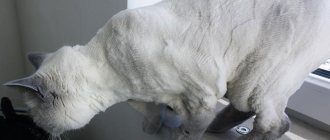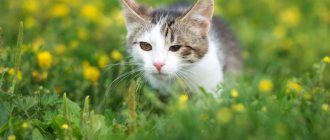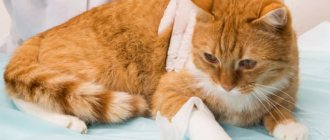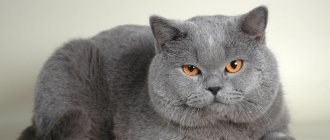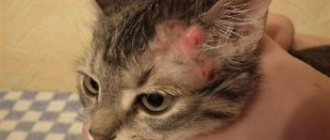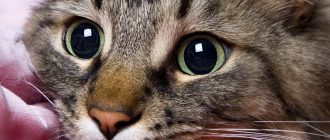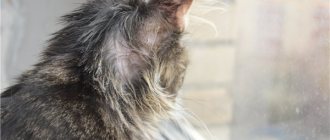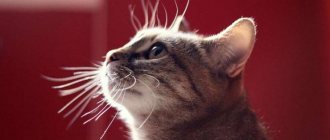Often, owners of long-haired pets are faced with such an unpleasant phenomenon as mats in their cats. Fluffy mustaches are distinguished by their affectionate nature, peaceful disposition and delight the human eye with a beautiful fur coat that requires special care. The long and fluffy fur of pets needs to be protected and cherished, combed regularly, bathed with a special shampoo, and if necessary, use cat spray. Otherwise, the hair falls off, it becomes impossible to comb out the dense icicles, and all that remains is to trim the cat, which will immediately affect the pet’s well-being and appearance.
What is it: how to recognize pellets?
In the coat of cats, a regeneration process is constantly taking place; the coat has the ability to renew itself and get rid of old hairs, which must be urgently removed by combing. If this is not done, the fallen hairs become entangled with the growing ones, tangles appear that are almost impossible to comb out, since such a procedure will cause severe physical pain to the pet. In this case, the pet’s owners will have no choice but to cut out the matted fur. As a rule, matting of pile with the formation of dense clumps in long-haired cats is observed in the neck, “pants”, tail, but can often be found on the back, stomach and the entire body of the animal.
A short-haired cat is much less likely to experience pellets in its fur. But if the pet is not provided with normal care, the cat is not bathed, its coat becomes dirty in the same way, the hair rolls off, tangles appear, which are no easier to remove than in the Persian.
Can cats have dandruff?
Many people are surprised when they hear that cats have dandruff. But if we think based on physiology, then this is a completely common, although not frequent, phenomenon. The processes of skin renewal are constant, and old skin flakes need somewhere to go and they get stuck in the cat’s thick coat. The layer of particles on the wool can be dry or oily. The root cause of the sebaceous layer is often seborrhea.
global $ads_google; //data-ad-slot=”2475549904″ $ads_google = empty($ads_google) ? false : true; ?> if ($ads_google == false) {?>
$ads_google = true; ?> } ?>
If the dead horny layer looks like crumbled flour or even snow, then they talk about the dry variety, and with the oily type, the hairs at the base look stuck together and greasy. The type of disease depends on the individual characteristics of each pet’s body.
For some owners, this can be dangerous due to an allergy to cat dander, since a lot of cat saliva remains in the matted fur.
Causes: where do they come from?
Breeds with long and lush coats require regular grooming.
It is easier to protect your pet from skin problems than to treat serious consequences later, because when the fur becomes tangled, it is not only a spoiled appearance of the cat, but there are also many reasons that lead to serious illnesses for the pet. Sometimes a long-haired cat is simply not able to take care of the condition of its lush hair on its own, so the owner is obliged to help the pet in this difficult matter by providing regular care.
Causes of tangles in short-haired and long-haired cats:
- Poor nutrition. Poorly selected food causes an imbalance in the gastrointestinal tract of animals, which leads to skin problems and dandruff, which directly affects the condition of the coat.
- Poorly organized bathing. Many owners bathe cats with cosmetic shampoos, not realizing that preparations with specific fragrances are dangerous for the cat’s fragile coat.
- Pollution factor. Matted fur may indicate the presence of dirt on the animal's coat, which the mustache cannot remove on its own.
- Presence of parasites. The first sign that fleas or lice have appeared in a cat's hair is dull, brittle hair that has rolled up and formed tight tangles. Simply cutting off the pellets will not work; treatment is already needed.
Dandruff on a cat's back near the tail
Such a phenomenon as bran from dead skin on the body of a pet can appear near the tail. Sometimes the cat's heavy weight is cited as the reason - he is simply not able to clean the fur in this area. , tail dandruff only bothers the owner, but if the problem is not solved, then in addition to the unpleasant odor from the animal’s skin, hair loss in this area may begin.
Dandruff on a cat's back can be either dry or oily. The color of the scales does not depend on the color of the fur coat: the particles are gray, white and yellowish. If the color of the dead particles is black, this indicates parasites or fungal diseases in the cat. In any case, the first thing you should do is visit a veterinarian and get blood tests and cultures for the pathogen.
How to get rid of it: quick help for your pet
If you feel the smallest hairballs, they should be removed immediately.
If the cat is provided with regular care and the animal's thick hair is regularly combed, then it is not difficult to detect a dense mat. Even with simple stroking, a dense formation is felt under the hand among the smooth coat. Removing clumps is an unpleasant procedure for both the cat and the pet owner. However, the mandatory nature of the process is not discussed, because if you do not untangle the tangled fur in time and do not rid your pet of annoying lumps, then an unplanned haircut for the cat is guaranteed.
You can quickly remove mats from your cat at home using the following diagram:
- If a lump has formed on a short-haired cat, a water procedure and thorough combing will be enough. It is possible that matted wool that has become matted will not need to be trimmed.
- If the pellet has been matted recently and does not yet have a dense structure, it can be carefully disassembled with your fingers without causing pain to the cat, the villi will be smoothed out and there will be no need to cut off the area of fur.
- If strong tangles are located throughout the animal’s body, you can try to preserve at least part of the affected cover. You should cut the seals along the hair growth, cut off the most hopeless areas and comb the thick pile with a stiff cat brush. Having treated one area of the body, you should comb the cat’s fur to the other side and repeat the manipulation.
When your beloved cat actively resists such procedures, and there are a lot of tangles in the fur, it is better to cut out the seals with children's scissors with rounded edges. In this case, the animal can break out and scratch, so the owner will need the help of third parties. If the mission turns out to be impossible, you should seek help from professionals at a grooming salon.
Diagnosis of seborrhea
Dandruff in a cat is accompanied by itching, the pet begins to itch a lot and often, and a whitish coating is noticeable on the fur. This is a reason to contact a veterinarian. After the initial examination, the doctor asks the owner about living conditions, feeding, visiting a grooming salon, taking vitamins or medications. Such information allows us to determine the causes of the disease.
Often it is enough to eliminate the provoking factor to get rid of seborrhea.
If external factors are excluded, it is necessary to undergo a number of tests:
- CBC (general blood test);
- biochemical;
- urine;
- for hormones;
- skin scraping;
- for parasites;
- biopsy.
The samples are taken in a veterinary office or center. Based on their results, the veterinarian diagnoses the disease and prescribes therapy.
Why they are dangerous: hidden dangers for animals
Hairballs that seem harmless at first glance can cause significant harm to your beloved pet. The games of kittens and adults are very exciting; while playing, a cat can get caught in a tangle on a foreign object and injure itself with a thoughtless jerk. Such a moment will be forever imprinted in the mustache’s memory and the animal will no longer allow you to touch its fur. If we delve deeper into the topic, tangles are not a disease and do not pose a direct risk to the life of the animal. However, the reasons that encourage you to remove and deal with unkempt fur are quite valid:
- ugly looking cat;
- discomfort for the animal;
- formation of dandruff and diaper rash on the skin;
- the possibility of wounds and ulcers;
- a favorable environment for the development of parasites, fungi and harmful microorganisms.
Types of dandruff and places of its localization
Dandruff on a cat's back near the tail occurs regardless of gender, age or breed. Based on the factors that provoke the disease and the areas where skin flakes are distributed, dandruff is classified into oily and dry.
- In the dry form, the particles resemble starch. They appear all over the body and are easily eliminated by stroking in the opposite direction to hair growth. The cause of the dry form is a malfunction of the sebaceous glands, drying out, and keratinization of the epidermis.
- The fatty form of the disease is divided into liquid and thick. Scales accumulate around the tail and ears. With thick, oily dandruff, the keratinized plates are noticeable only if the pet scratches intensively behind the ears. In this case, large whitish flakes appear. If you disassemble the hairs, you can see tubercles on the cat’s skin - an accumulation of oily seborrheic particles.
The liquid type of oily dandruff in cats manifests itself in the form of sticky, “dirty” fur. The cat looks untidy, its fur sticks together and climbs. However, bathing is ineffective. After 2-3 days, the symptoms resume, and the coat looks dirty again. Liquid seborrhea has a gray, beige or yellow tint. Black scales indicate infection with skin parasites or mycosis (fungus).
If the location of peeling constantly changes, it is worth assuming infection with parasites (hypodermic mites). Hair loss is the initial symptom of dermatitis, adenitis or lichen.
Prevention measures: how to avoid?
It is much easier to protect your beloved animal from possible problems with its fur than to later eliminate problems in its history. Moreover, precautionary rules must be observed from the very birth of the kitten; newborn long-haired pets are also at risk of developing mats. To prevent the hair from matting and the cat to have a beautiful silky coat, you need to follow a few simple rules of cat hygiene:
- Brush your cat regularly, at least 3 times a week, preferably every day. Use a hard brush with thick teeth.
- Buy a special anti-matt product, perhaps a softening shampoo or balm for bathing cats.
- When bathing, do not fluff the hair, apply shampoo with light stroking movements, also foam and rinse the animal from the product.
- It is recommended to dry animals with a hair dryer, this helps prevent the formation of tight lumps due to improper drying.
The functionality of the gastrointestinal tract directly affects the condition of hair in cats. If the fur sticks together, has not grown back since the last haircut, and the entire fur coat is covered in ugly icicles, this is an alarming signal about a violation of the internal organs. First of all, your pet should be shown to a veterinarian to rule out a possible disease. Cat food should be of high quality, preferably with protein supplements. It won't hurt to pamper your pet with vitamins and minerals.
Prevention of tangle formation
To prevent tangles from appearing, the cat needs to be looked after daily
To avoid the hassle of removing tangles, you can simply prevent their formation. To do this, you need to make it a rule to devote some time every day to caring for your cat. Pets with mustaches need to be combed. If the animal came into the house while still a kitten, then it needs to be taught to use a comb right away. The daily procedure will become a habit, and when the cat grows up, there will be no problems with combing. However, you cannot simply comb a cat with your own (“human”) comb. Each pet should have its own toiletries. For a cat, you need to select a comb depending on the type and length of hair. For young cats and kittens you need to purchase a brush. Artificial bristles (for example, nylon) have an antistatic effect and do not “cut” the hair to the skin.
I brush my cat with a brush. Although Khosya has already grown up and turned into an adult, capricious cat, she is not going to give up the brush. She rejects other combs. And since Hoshi has short, smooth fur, you don’t need to change the comb. The only thing I don't like about the brush is that small hairs get stuck in the bristles (the depth of the tufts). Sometimes I have to comb Hoshin's brush with a simple plastic comb.
Additionally, you can purchase a rubber (massage) mitten. This little thing will help comb the fur even after bathing (before it dries). But a mitten cannot replace proper combing. Combs are suitable for daily hygiene. The tips of the comb teeth are rounded, which facilitates painless combing. Combs can be of any length and width. This comb will help identify fleas if any appear. If you like both combs and brushes, you can purchase a double-sided comb (brush). For very fluffy cats with long hair, a slicker is needed. The slicker resembles a brush, but instead of bristles, thin metal teeth (with curved ends) protrude from the rubber pad. Slickers are needed for combing out fluff, but it can only be used to care for cats with healthy, good fur. If your pet already has tangles, the slicker cannot be used.
If possible, you can buy a furminator. This is a special device (comb-trimmer) for combing out the undercoat. Not the most budget option, but using such a trimmer saves time. Furminators are sold for different types of cats (kittens, short-haired, long-haired).
Photo gallery: types of combs for grooming cats
brushes are ideal for kittens or short-haired cats
Instead of a mitten, you can use a special attachment for your hand
the longer the guard hairs of the animal, the denser the comb teeth should be
In addition to a double-sided brush, you can also use a double-sided comb
The longer the cat's fur, the longer the teeth of the brush should be
Furminator is one of the most expensive “combers”, but also one of the most effective
In addition to brushing, you also need to bathe the cat. Of course, you don't need to wash your pet every day (only as needed). Cats with long hair find it difficult to lick their “coat” completely (especially if there is dirt on the fur). Do not wash your cat with regular shampoo or soap. There are special shampoos and conditioners for animals. After shampooing, the coat may not dry properly, which is why conditioner is needed. Some pet stores also sell dry shampoos for animals. Owners of long-haired pets need to have one (in case the water is turned off and the cat gets dirty). Dry shampoo will not solve all problems, but dirt will be eliminated, static tension will disappear, and the coat will become more manageable.
Some cat breeders dry their pets with a hairdryer after bathing. This procedure must be carried out extremely carefully (air heating should be minimal). This drying can be done while simultaneously brushing the cat with a massage mitten. In this case, the wool will dry correctly and completely.
And also do not forget about proper nutrition of the animal. After all, the formation of tangles can be caused by poor wool quality (for example, dryness, brittleness). This can happen due to a lack of vitamins. Your veterinarian will help you choose the right food supplement.
Symptoms of the disease
It is believed that cats are more susceptible to this disease than others, but it can also occur in cats. Moreover, some breeds are more at risk than others of developing such an unpleasant and difficult-to-treat disease. For example, the Scottish Fold cat is often noted to have a hard tail, while according to breed standards its mobility is especially valued. With such a disorder, a “greasy tail” may also occur.
But the Persian cat is more susceptible to acne, which causes her not just discomfort, but can cause a serious illness. In addition, representatives of any breed, and even outbred cats, can have a fat tail.
In short-haired or “hairless” breeds, it is much easier to detect such a defect, but it is much more difficult to detect it in an animal with a luxurious, bushy tail. Most often, it is discovered by chance, when the process has already started and done its dirty deed.
Greasy tail syndrome is accompanied by the following symptoms:
- The fur at the base of the tail becomes very greasy, covered with thick secretions, which are very difficult or impossible to wash off using simple methods, at least from the first approach.
- On the skin at the base of the hairs you can see tubercles, which can be inflamed, covered with rough scales, and a purulent crust.
- When the disease is advanced, a whole scattering of inflamed pimples or scars from scratching may be found on the skin.
- When the fur suffers from greasy hair, it can break off at the base, leaving the affected area exposed or looking as if the hair has been clipped or pulled out.
- When the anal glands are inflamed, the animal tries to get rid of their excess contents by crawling with its backside on the floor, and sometimes on the carpet.
- With acne, a greasy yellowish spot first appears on a cat's fur, then a “black dot”, and in the absence of care and treatment, a hard crust forms, under which there may be an inflamed or abscessing acne.
Features of this disease
According to statistics, such a disease most often occurs in uncastrated cats; in their castrated counterparts it occurs much less frequently.
Hyperplasia of the paraanal gland
leads to the fact that a huge amount of secretion accumulates in excess on the cat’s skin, which gets onto the mustache’s fur and contaminates it, giving it, in turn, a very greasy appearance.
In non-castrated animals, this disease also occurs in representatives of non-furry breeds, but fluffy-tailed ones are more susceptible to it.
This disease is specific to such breeds of the cat family as:
- Rex.
Causes of oily tail hair
A cat is an animal that walks on its own; it comes home to eat, sleep, and then, having satisfied its needs, hits the road again.
Oily tail hair may appear for the following reasons:
- A cat can get its tail into something greasy and thereby dirty its tail. In this case, washing the animal and thoroughly drying it will help.
- A cat can be soiled by children, who are generally the greatest aggressors for all cats. Children love to pet animals, carry them everywhere, and constantly squeeze them. It’s no wonder if one such mischievous child jumps out from behind the dinner table with dirty hands and accidentally wipes them on the tail of his beloved pet when he, in turn, tries to escape from the little monster.
- But for the most part, this problem has a fairly serious basis in the form of a disease associated with increased activity of the perianal glands. This problem can be identified only by one symptom: the cat constantly crawls on the carpet with its butt. In a similar way, the animal cleanses its perianal glands, squeezing out all the excess contents, which in turn ends up on the animal’s fur, making it very oily.
- One of the reasons for the appearance of oily hair in a cat can be considered diseases such as oily seborrhea and a violation of the keratinization process
.
Treatment options
Treatment for a cat with “greasy tail” will most likely be lengthy and not the most pleasant for both the owner and the animal itself. If your beloved Scotsie or other breed just doesn't want to bathe, he'll need to be bathed regularly using a shampoo like Lactaderma, which contains lactic acid.
It promotes good washing of fur and skin without drying it out, and also helps to gently exfoliate keratin accumulations. After such care, even the laziest cat’s fur will stop getting greasy and become beautiful and fluffy.
If the problem is caused by high hormonal levels, the doctor will recommend castration or other procedures. If the anal glands are to blame, they can be washed or emptied manually. If the disease recurs regularly, the veterinarian will train cat owners to do this at home. If the disease is chronic or severe, surgery to remove the glands may be recommended.
As a general tonic, the veterinarian can give recommendations on the use of special vitamins, as well as change the usual diet.
In the presence of acne, increased keratinization, and blackheads on the skin, special shampoos are used. From a large list of such products, we can name Dermilen and Meladerm. They are aimed at treating oily seborrhea and can prevent the spread of the disease, prevent the infection from “settling” and the development of chronic eczema.
Treatment of a cat's tail can be complex and lengthy, but it must be done, since without proper attention to the problem, irreparable changes can develop, in particular, the cat can be left with a hairless tail, like a rat's.
Treatment at home
The owner must take the animal to the veterinarian. The first stage of diagnosis is collecting anamnesis. The doctor asks the owner about the pet’s lifestyle, dietary habits, chronic diseases, hygiene products used, and other factors that can cause seborrhea.
The second stage of diagnosis is testing:
- blood for general, biochemical, hormonal tests;
- biopsies;
- skin scraping.
Based on the results of diagnostic studies, the doctor will prescribe comprehensive treatment. Symptomatic and essential drugs are used. The first - external ointments, preparations for bathing - normalize the condition of the skin. The latter eliminate the cause of seborrhea.
How to treat dandruff in a cat depends on the cause of the pathology. Apply:
- Medicines against internal disease that provoked seborrhea.
- Vitamins.
- Antihistamines to eliminate skin allergic reactions (the owner may also need to take antihistamines, because there is an allergy to cat dander).
- Anti-inflammatory drugs for the inflammatory process.
- Anthelmintic, antifungal, antibiotic medications for infection.
- Hormonal drugs.
- Diet for obesity and food allergies.
- Massage to improve blood circulation in the skin capillaries.
A diet for a cat suffering from seborrhea excludes the consumption of fatty, high-calorie foods. The pet should eat high-quality store-bought food with a high content of retinol, B vitamins, and omega acids. These substances normalize metabolism, have an antioxidant effect, and ensure healthy skin and coat of the animal.
Brush your cat regularly with a natural bristle brush. The procedure accelerates the blood to saturate the hair follicles and accelerates skin regeneration!
In winter, when the heating radiator is running, regularly humidify the air in your home, place bowls of water on the windowsills, and buy a humidifier. Do not allow sudden temperature fluctuations, do not allow the cat to bask near the radiator for a long time, or lie in the direct sun. Do wet cleaning regularly and do not allow your pet to come into contact with street animals.
Anti-dandruff shampoos for cats
Pet stores have a wide selection of products to help cure dandruff. To buy the right shampoo, read the ingredients. Anti-dandruff shampoo for cats contains:
- zinc – a healing component that accelerates regeneration;
- chlorhexidine – antiseptic;
- salicylic acid – accelerator of healing and exfoliation of dead skin particles;
- vegetable oils – softening, anti-inflammatory, regenerating components;
- plant extracts – means of healing and strengthening the coat.
beaphar anti-dandruff shampoo for cats and dogs
When bathing, apply the product to the coat, massage for 3-5 minutes. Once a month, in addition to shampoo, rinse with herbal decoctions (calendula, string).
Choose a shampoo according to your cat's coat type and type of seborrhea to avoid complications.
Vitamins for dandruff
Vitamins are useful if seborrhea appears as a consequence of poor nutrition and impaired metabolism. But the veterinarian is highly likely to prescribe them for other causes of pathology.
There are universal complexes for general improvement of the condition of the skin and coat, and there are vitamins with targeted action: to activate the growth of the integument in cats, reduce allergies, and normalize the functioning of the sebaceous glands.
Popular vitamins that help get rid of dandruff:
- Beaphar Laveta Super for Cats;
- Sherstevit;
- Canina Petvital Derm Liquid;
- Canina Cat-Fell OK;
- Canina Cat Felltop Gel.
Sherstevit-vitamins for cats and dogs
Anti-dandruff spray for cats
The use of anti-dandruff spray for cats is justified when parasites appear in the fur. The veterinarian selects the product and prescribes the dosage. You can remove fleas from cats using drops on the withers. High-quality preparations, for example, Tropiclean OXY-MED spray, help not only to eliminate parasites and cure seborrhea, but also to remove swelling and itching, normalize the functioning of the sebaceous glands, and improve the health of the coat.
Keep your cat clean and comfortable, feed it well, do not expose it to stress, take care of its fur, then you will not have to treat dandruff. If the skin is very flaky, be sure to take your pet to the vet. Do not treat the animal yourself; mistakes will aggravate the condition.

